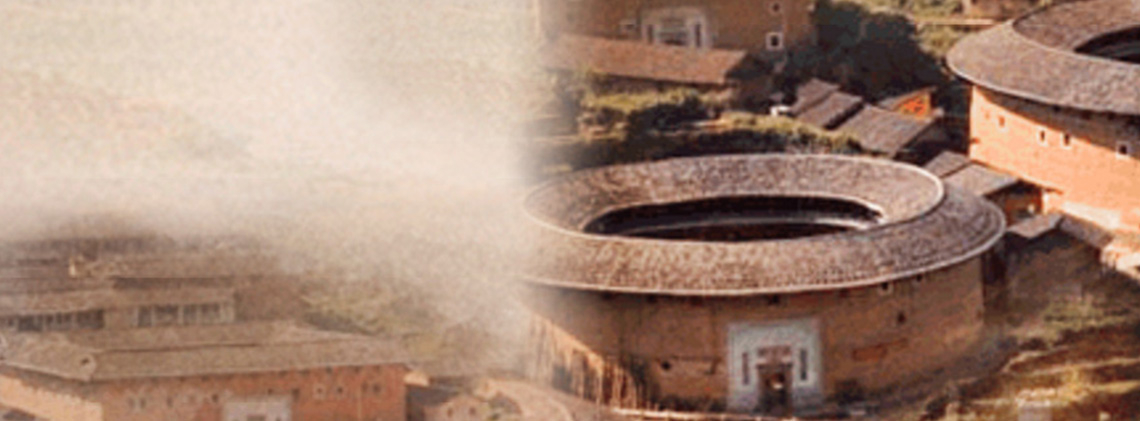
Fujian Tulou
Splendid
Chi Culture
Topic
Fujian Tulou
There is a folk story circulating in Fujian about the tulou discovered by American satellites. During the Cold War in the 1960s and 1970s, the White House panicked at what looked suspiciously like nuclear reactors in western Fujian. They were detected by the Central Intelligence Agency (CIA) in satellite photos. However, even after examining countless other satellite pictures, the CIA failed to solve the mystery of the suspected “nuclear silos” for the next two decades. The story continues that after China adopted its policy of opening-up to the world, CIA agents, disguised as tourists, went to Fujian to investigate, only to find those “silos” were in fact long-established tulou, or earthen houses. It was not until then that the Americans could set their hearts at rest.
Leaving aside the question of authenticity, this popular tale is at least reasonably grounded in reality.
Fujian Tulou, officially inscribed on the World Cultural Heritage List by the United Nations Educational, Scientific and Cultural Organization (UNESCO) in 2008 as China’s 36th cultural heritage site, is visited annually by a large number of Chinese and foreign tourists. People marvel at the “mysterious ancient castles of the Orient,” and a Japanese architect has remarked that a tulou looks like a flying saucer falling from the sky, or a mushroom coming out of the earth. Steven Andres, consultant for UNESCO, praised them highly as “the world’s unique and mythical mountain residential architecture.”
Fujian Tulou, a type of residential building of two or more stories, is constructed by proportionally mixing clay, sand, lime, and other building materials and ramming the raw mixture into thick walls. These robust mud houses, built mostly by the Hakka people of Fujian, are symbolic embodiments of traditional Hakka life and culture. Thus, the structures are also called Hakka Tulou. The Hakka’s origins can be traced back to Chinese populations that had lived for centuries in the Central Plain but were forced southward on a large scale and in successive waves beginning in the fourth century to escape frequent wars in northern China following the break-up of the Han empire. Living among local residents, the Hakka (or “Keija,” in Mandarin, which means “guest people”) who migrated into southern Fujian became the Hoklo ethnic group and spoke the Minnan (southern Fujian) dialect. The groups of “guest people” who settled in the mountains of western Fujian formed the Hakka ethnic group and spoke the Hakka dialect.
Ancient Chinese populations living in the Central Plain have used rammed earth in the construction of city walls and other buildings as early as 4,000 years ago. Rammed-earth structures were gradually replaced by fired brick structures in the Central Plain after the fourth century, but the architectural form was carried southward by fleeing Han populations to south and southwestern Fujian.
Statistics show there are more than 30,000 tulou in Fujian, mainly in the southwest cities of Longyan and Zhangzhou, with the largest number of over 16,000 in Yongding district of Longyan. Most existing tulou in China were constructed in the Ming (1368–1644) and Qing (1644–1911) dynasties. The earliest dates to the Tang dynasty (618–907) and the latest was built in the year 1962.
Round or square in shape and with walls about 1.5 meters thick, most tulou are several hundred years old, but still very strong and inhabitable. They survived a 7-magnitude earthquake which struck southwestern Fujian in 1918. Amazingly, a 50-centimeter crack, which emerged in a tulou built in 1693, later closed up naturally.
A tulou can house dozens or even hundreds of people, generally of the same clan, who divided themselves up into smaller family units and lived together in harmony. The centuries-old habitation in tulou settlements, which offered both shelter and a spiritual home to the Hakka people, has developed into the unique Tulou culture of China.
Today, as a result of the younger generation’s pursuit of independent living and greater privacy in rural areas, low construction costs of modern-style houses, and other factors, tulou have become less desirable as housing, and new ones are not likely to be built in the future. However, people still believe in the tulou way of life as a lasting social ideal. Fujian has formulated and promulgated various laws and regulations for the protection of existing tulou under its jurisdiction. One of these protections stipulates that government above the county level shall be responsible for the repair and maintenance of these earthen cultural heritage houses.



